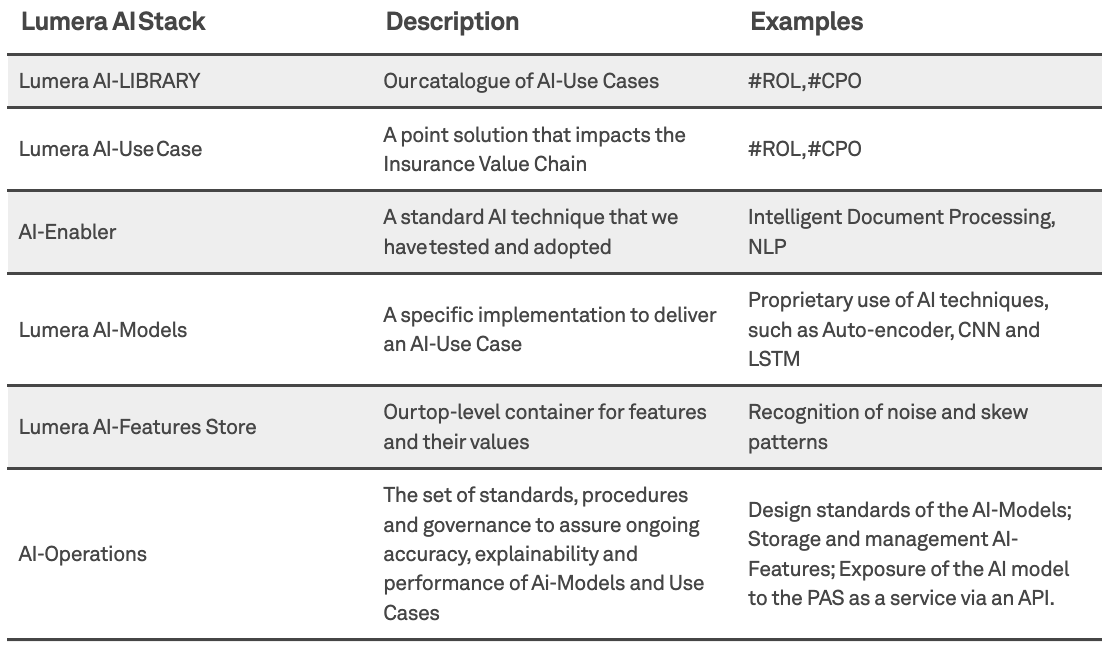
Lumera believes that the future of analytics and reporting for Life and Pensions companies is to have AI embedded in insurance Intelligent Data Warehouses (IDWs) that ‘shadow’ the firm’s in-productions systems of record, social media and other data sources such as CRM. What does this mean? And how will it work?
The insurance Intelligent Data Warehouse
Many Life and Pensions firms have invested in Data Warehouses or data lakes, often to abstract data from legacy systems that are too inflexible to support current and future analytics and reporting requirements. The bad news is that insurers have found that generic Data Warehouses or data lakes also require highly skilled, expensive resources to extract, interpret and present meaningful Life and Pensions insight.
We believe insurers will get smarter, faster, and more actionable outputs and insights by deploying insurance-specific AI models on IDWs that recognise and understand the meaning and value of the policy data they contain.
The IDW sits alongside the firm’s policy administration systems. It extracts policy data from various systems of record, transforms the data into a single format and uploads the data into the IDW, either in near real time or overnight. This ETL (Extract, Transform, Load) layer is highly automated and requires a management service to ensure that the IDW is fully and correctly populated as the systems of record, compliance and other reporting requirements evolve.
For example, as UK regulators require insurers to demonstrate that they are following Consumer Duty principles, it will become imperative to provide more granular data to enable policyholder level analysis for compliance. Such requirements include avoiding foreseeable harm or taking all reasonable steps to enable customers to pursue their financial objectives.
What makes the IDW insurance intelligent?
AI is embedded in the IDW. Introducing AI into business analytics means that over time, predictions and recommendations will become more accurate and meaningful. Al transforms traditional, rules-based, deterministic automation by introducing probabilistic reasoning and the ability to continually adapt the automation to deliver accurate results as the environment evolves.
The IDW includes an abstraction layer called an AI Feature Store in which we manage the various features that serve as the inputs to AI models. AI Features are selected to generate the greatest explanatory and predictive power in a Life and Pensions environment using the minimal set of assumptions. Further, as many of these inputs require computationally hungry calculations, they are optimised for performance and resource usage. As a result, the AI models start with a ready-for-action set of building blocks that have been optimised over large data-pipelines and periods of time. The AI Features will need to be actively managed as the environment evolves to ensure ongoing compliance and explainability and prevent degradation.
AI Terminology – What Does it all Mean?

The IDW can take advantage of a full range of embedded AI techniques, such as Anomaly Detection, by which algorithms can expose anomalous data that clients weren’t even looking for. Al can identify unsuspected segments and identify hidden factors that drive the segmentation.
Finally, the IDW has the capability to hold all the product rules and premium history at a granular level. It has a full understanding of insurance concepts such as premium history, partial surrenders and claims. The combination of a Data Warehouse that can fully map the data and functionality of the systems of record with insurance-specific AI models embedded is what makes the AI-powered IDW insurance intelligent.
Incorporating external data
The IDW may also bring in relevant data at fund and policy level from external systems. The FCA’s stated aim is to support the financial sector in driving positive change, including the transition to net zero. HM Treasury has announced that firms will be required to publish their net zero transition plans as part of the Sustainability Disclosures Regulation (SDR). The IDW provides the platform to map external environmental, social and governance (ESG) ratings at company or fund level to policies and policyholders. Once the IDW is established, automation can be set up to provide data to a BI, a reporting system, or a pensions dashboard.
A new world of AI-powered analytics
Firms with multiple legacy policy administration systems face a daunting prospect of deploying AI consistently across their business. By bringing the data and rules from multiple systems into one IDW, the firm has a single, modern Data Warehouse with AI embedded. The IDW can serve as a non-production environment in which to run AI predictive models, such as Risk of Lapse, on real data. We can use AI predictive analytics to support the automation of the analytics process and discover new insights over time.
A training ground for AI
Because the IDW provides a non-production mirror of the policy-level data across the production systems of record, it is an ideal training ground for AI models that the client intends to deploy on live systems. The IDW contains the business rules, premium history, etc, and can be rolled backwards and forwards to teach the AI models on real data against known outcomes. Not only will this dramatically accelerate the deployment of AI-powered automations, but also facilitate their ongoing maintenance to ensure that accuracy and relevance does not erode but rather continues to improve.
Take me back
Stockholm
—
Regeringsgatan 28
111 53 Stockholm, Sweden
Phone: +46 8 4109 4000
Email: info@lumera.com
London
—
8 Frederick's Place
London EC2R 8AB, UK
Phone: +44 345 862 3440
Email: info@lumera.com